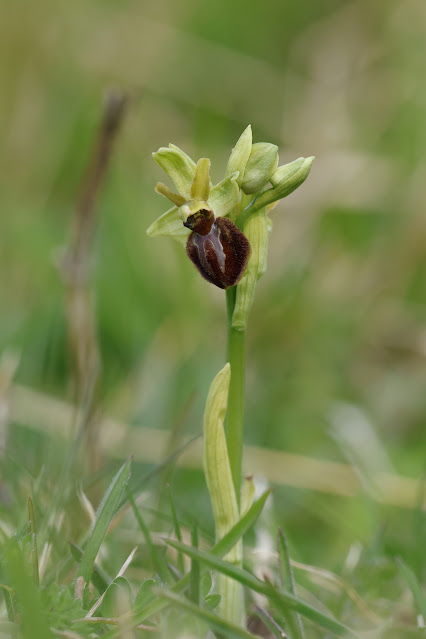Today Peter had planned a trip to Dorset to see them at the 320 acre Durlston Country Park and National Nature Reserve which is near Swanage in Dorset and suggested I might like to come along which I willingly accepted as he also offered to drive.
I always find driving to anywhere in Dorset a chore as the roads nowadays, once past the New Forest are inadequate to accommodate the large amounts of vehicles that now wish to use them. Couple this with the fact it was school half term and sunny and it did not augur well.Thus a journey of just over a hundred miles seemed double that due to the time it took to get there - two and a half hours.
We duly arrived at Durlston CP around lunchtime and, with only a vague idea of where to go and look for the orchids, logically headed for the Visitor Centre for some guidance.We got some of sorts from a not very enthusiastic lady ranger and eventually the two main areas to locate them were pointed out to us on a static display. We should have requested a map with specific directions but we got the impression that we were not the kind of visitor, arriving with a specific target in mind, that they really catered for.
Primarily a Mediterranean species and closely related to Bee Orchids, the Early Spider Orchid is at the northernmost limit of its range in southern England where it is considered to be local and uncommon. They grow in coastal areas, mainly in Kent, Sussex and Dorset but one was found as far north as Northamptonshire in 2001.The first record there for 230 years.
Flowering from mid April until the end of May they were the earliest orchid species to flower in Britain until the colony of Giant Orchids was discovered in my home county of Oxfordshire in.2022.
As with much of our specialised flora it has suffered from habitat degradation such as ploughing and changes in grazing regimes but in places where the land management is sympathetic it still thrives in good numbers on its favoured closely grazed, unimproved chalk grassland.
Early Spider Orchids have a three year growth cycle from seed to flower and the success or otherwise of the plant's setting seed is the main factor in affecting the orchid's numbers. They are small, growing from 5-30cm tall and the ones we came to see here in Dorset are said to be at the smaller end of the spectrum, ranging from 2-7cm in height.The lip of the flower is coloured a deep rich brown with a smooth blue grey mark shaped like the letter H at its centre but the orchid gets its name from the fact that the petals and sepals are long and slender and reminiscent of a spider's legs However it attracts its pollinator, the male Solitary Bee by sexual deceit as the round, convex, velvety lip of the flower resembles a fat, hairy female bee and even smells like a female thus attracting the male bee to attempt to mate with it and in the process he collects pollen on his head and body which gets transferred to the next plant he tries it on with.
We separated and crossed and re-crossed the field that glowed yellow with a profusion of cowslips but apparently with no orchids.
I looked up to call to Peter about my find but there was no sign of him as presumably he was searching elsewhere. I prostrated myself on the grass and took some images of the coveted orchid. Peter rejoined me and I moved over to allow him to take his shots. The ranger had said there were a good number of orchids to be found here but we only found one more and that only after a good deal of searching. Maybe we were too early?.
A rather fruitless period then ensued, where we separated once again and Peter failed to find any at the second location we had been told about near the Anvil Point Lighthouse.Frustrated and tired of tramping up and down the steep gradients and knowing there were definitely many on the downland slopes near the lighthouse we went back to the Visitor Centre for more precise directions. I waited outside while Peter went to find some staff who this time were much more co-operative about assisting us to see the orchids.
.JPG) |
| Photographing the orchids |
.jpg) |
| Anvil Point Lighthouse and the slope where we found many Early Spider Orchids |



.jpg)













No comments:
Post a Comment